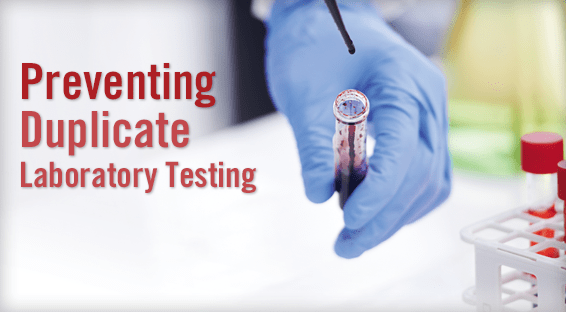Unwarranted duplicate laboratory tests have been shown to increase unnecessary phlebotomy, which can lead to iatrogenic anemia and associated sequelae, such as poor wound healing and a greater risk of infections. Such tests can also decrease patient satisfaction and increase healthcare costs. Although some phlebotomists understand when to consolidate orders, doing so requires approval from ordering physicians and consumes a considerable amount of time.
Addressing the Problem
For a study published in the American Journal of Clinical Pathology, Gary W. Procop, MD, MS, FASCP, FCAP, and colleagues sought to limit duplicate testing at the Cleveland Clinic. The team previously observed that it was ineffective to only include pop-up alerts in the computerized physician order entry (CPOE) system that warned physicians about a duplicate order. “We demonstrated that pop-up fatigue is real,” says Dr. Procop. “Only rarely did physicians read the alert. Many times, they simply clicked through the alert to close it and move on to their next task.”
After agreeing on more than 1,200 tests that a multidisciplinary test utilization committee felt was not needed more than once per day, a hard stop was programmed into the CPOE. The hard stop made it impossible for physicians to order any of these tests through the computer system, if they had already been ordered that day.
“The physician requesting a duplicate test would receive an alert notifying them that the test had already been ordered, and the system also provided the test result if it was available,” Dr. Procop explains. “We also built a workaround scenario in case physicians felt like they absolutely needed a duplicate test. They had to call client services, who would record the physician’s name, the test, and why the physician wanted a duplicate, before providing a code—which changed daily—to the physician for bypassing the system. With this, we could record how many duplicate tests were still placed. We found that this intervention was 91% to 95% effective in stopping duplicate orders.” During the study, 414 requests to override the duplicate order blockade were made, and all were granted.
When the investigators looked at the total number of times the hard stop alert fired when duplicate orders were attempted versus the number of orders that were permitted, they could see that many physicians were not reading the alert and trying to bypass it at the computer several times before realizing they were unable to do so (Figure 1). “The alert actually says ‘you can’t get this test. You must call client services,’” says Dr. Procop. “The fact that they’re not reading this demonstrates that allowing physicians to bypass the alert at the computer screen will lead to much lower compliance rates when compared with forcing them to call client services.”
Over the 2-year study, the Cleveland Clinic team’s initiative prevented nearly 12,000 unnecessary duplicate test orders, resulting in savings of $183,586 in materials and labor for laboratory personnel. The monthly savings found from preventing duplicate tests were small, says Dr. Procop, because the prevented tests were relatively low cost (Figure 2). However, because the tests tended to be commonly ordered, savings accumulated rather quickly over time. “The cost savings go beyond financial savings,” he adds. “Using this intervention, we’re obtaining better laboratory management and better test utilization because it has been integrated as a routine part of our practice. It’s not something that anyone has to actively do; it’s built into the system.” The savings gained from fewer needle sticks, specimen processing and transport, and review of the actions taken on tests were not calculated in the study, so it is likely that actual savings were much greater than what was reported, according to the researchers.
Applying the Intervention
Findings from the study are applicable beyond the Cleveland Clinic, according to Dr. Procop. “Physicians should engage their laboratory leaders, as well as the hospital administration and interested clinicians, to either form or revitalize a test utilization committee and look at best practices for the tests that are used in their institution,” he says. “Best practices should be the driver because, as we’ve shown, the healthcare savings will likely come. As soon as you make it about cost savings, healthcare providers may understandably shut down. What physicians are really interested in is best practices.”
Dr. Procop adds that hospital administrators should be interested in implementing the intervention used at the Cleveland Clinic. “When best practices are implemented, other benefits can occur, including shorter lengths of stay, lower readmission rates, and fewer hospital-acquired infections,” he says. “Interventions like ours are when laboratory and informatics teams can partner with hospitals and physicians to help decrease waste while actually streamlining practices.”




 TimH
TimH